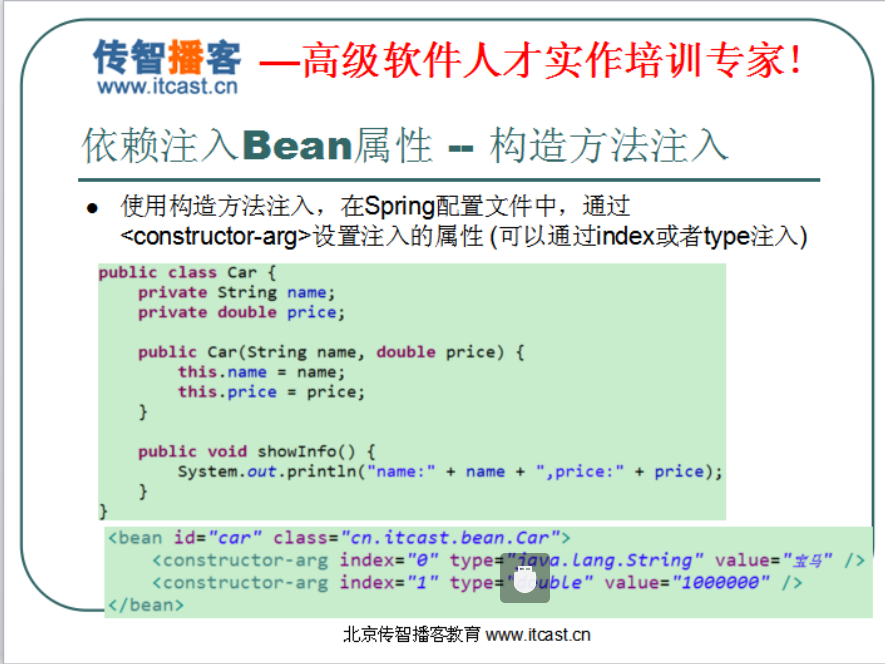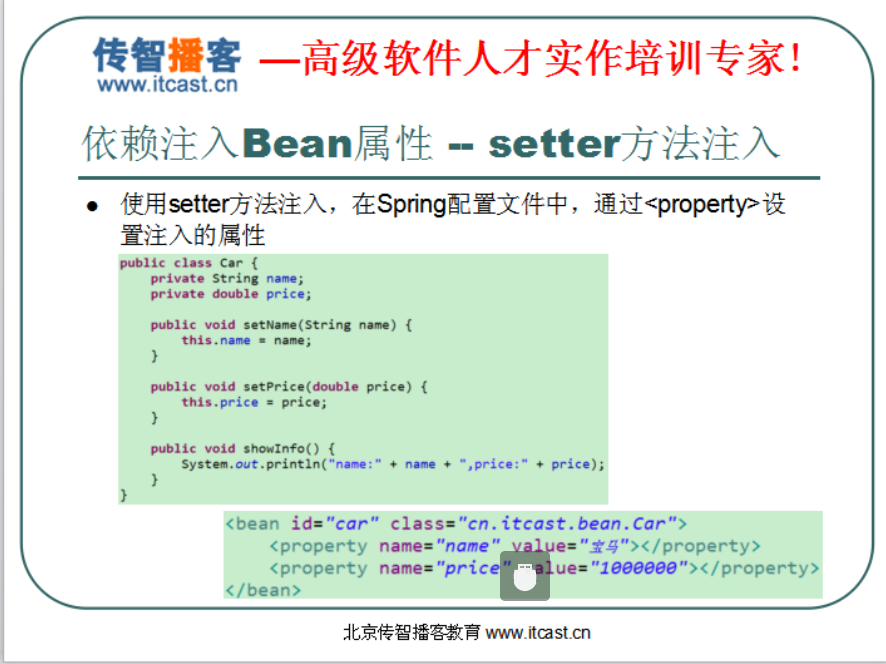后处理bean,如果是返回bean,那么什么都不做直接把这个类原封不动地给你返回回去。
在它执行一些逻辑方法的时候对它进行逻辑增强,比如说进行时间监控,权限管理,日志的记录等等。
要做肯定是对正常的类增强才可以,因为正常你就调用这个类的add或者find()方法了。
增强的方法:继承、装饰者模式、动态代理。
装饰者的缺点是:如果你的接口中的方法太多,而你只需要增强其中的某一个方法,那你这个类里面就得写特别特别多的方法。而且其他的方法都是原封不动地给人家返回的。
动态代理:最灵活。对这个类生成一个代理类,Proxy.newProxyInstance()对bean这个类生成代理。
public Object postProcessAfterInitialization(final Object bean, String beanName){
//不是对所有的类都增强,如果想对所有的类都增强,直接在这里生成代理类即可。
//如果只想对某个类增强,判断这个类的名字是不是我们在Spring中注册的那个customerService.
//Spring可能配置了非常多的类,但是我只增强customerService.如果你配置了b1、b2、b3,那么b1、b2、b3正常也会执行我们的后处理bean.
//调用业务的任何一个方法(调用add()或者是find())都相当于执行InvocationHandler的invoke()方法.那就可以在它执行之前或者是之后做一些事情.
//不管怎么做都会生成一个customerService的代理类.代理类才有增强的代码,不是代理类就没有增强的代码.所以判断,如果这个类是customerService,返回代理类;如果不是customerService,把没有增强的类返回.
//通过后处理bean对某些类进行增强.
}
其实Spring AOP的思想的有一部分是基于后处理bean。
package cn.itcast.spring3.demo5; import org.junit.Test; import org.springframework.context.ApplicationContext; import org.springframework.context.support.ClassPathXmlApplicationContext; public class SpringTest5 { @Test public void demo5(){//Spring注入属性的两种方式:一种是构造器的注入 ApplicationContext applicationContext = new ClassPathXmlApplicationContext("applicationContext.xml"); Car car = (Car) applicationContext.getBean("car"); System.out.println(car); } @Test public void demo6(){//还有一种是setter方法的注入 ApplicationContext applicationContext = new ClassPathXmlApplicationContext("applicationContext.xml"); Car2 car2 = (Car2) applicationContext.getBean("car2"); System.out.println(car2); } }
package cn.itcast.spring3.demo5; public class Car2 { private String name; private String price; public String getName() { return name; } public void setName(String name) { this.name = name; } public String getPrice() { return price; } public void setPrice(String price) { this.price = price; } @Override public String toString() { return "Car2 [name=" + name + ", price=" + price + "]"; } }
package cn.itcast.spring3.demo5; public class Car { private String name; private Double price; public Car() { super(); } public Car(String name, Double price) { super(); this.name = name; this.price = price; } @Override public String toString() { return "Car [name=" + name + ", price=" + price + "]"; } }
<?xml version="1.0" encoding="UTF-8"?> <!-- 别去schema,schema是文件,本地的文件,你得引那个头 --> <beans xmlns="http://www.springframework.org/schema/beans" xmlns:xsi="http://www.w3.org/2001/XMLSchema-instance" xsi:schemaLocation=" http://www.springframework.org/schema/beans http://www.springframework.org/schema/beans/spring-beans.xsd"> <!-- demo1快速入门================================================= --> <!-- 把接口和实现类在这个配置文件中配置,有了实现类的全路径之后到时候才能用工厂反射 --> <!-- 通过一个<bean>标签来设置类的信息,通过id属性为类起个标识. --> <!-- 接口,实现类,配置文件也都有了 --> <!-- 现在有一个工厂Spring为我们提供好了,其实就是解析这个XML文件 --> <!-- 这个工厂你自己写会不会写?你用dom4j找里面的bean标签,找到class的属性值,然后就可以Class.forName()反射生成类的实例.其实Spring 也是这么做的,只不过工厂由Spring提供好了 --> <bean id="helloService" class="cn.itcast.spring3.demo1.HelloServiceImpl"> <!-- 使用<property>标签注入属性 value指的是普通值 ref指的是对象 --> <property name="info" value="传智播客"></property> </bean> <!-- demo1快速入门 --> <!-- demo2Bean的实例化 --> <!-- 默认情况下使用的就是无参数的构造方法. --> <!-- <bean id="bean1" class="cn.itcast.spring3.demo2.Bean1"></bean> --> <!-- <bean name="bean1" class="cn.itcast.spring3.demo2.Bean1"></bean> --> <!-- 第二种使用静态工厂实例化 不能写class了,因为现在不是由Spring直接帮你创建对象了--> <!-- <bean id="bean2" class="cn.itcast.spring3.demo2.Bean2Factory" factory-method="getBean2"></bean> --> <!-- 第三种使用实例工厂实例化 --> <!-- <bean id="bean3" factory-bean="bean3Factory" factory-method="getBean3"></bean> --> <!-- 要先把Bean3Factory实例化 --> <!-- <bean id="bean3Factory" class="cn.itcast.spring3.demo2.Bean3Factory"></bean> --> <!-- demo2Bean的实例化====================== end--> <!-- demo3Bean的作用范围======================= --> <!-- <bean id="customer" class="cn.itcast.spring3.demo3.Customer" scope="prototype"></bean> --> <!-- <bean id="product" class="cn.itcast.spring3.demo3.Product" init-method="setup" destroy-method="teardown" scope="singleton"> <property name="name" value="空调">--> <!-- 把Product类的属性name注入进来 --> <!-- </property> </bean> --> <!-- demo4Bean的生命周期======================= --> <bean id="customerService" class="cn.itcast.spring3.demo4.CustomerServiceImpl" init-method="setup" destroy-method="teardown"> <property name="name" value="itcast"></property> </bean> <!-- 后处理Bean是由Spring容器自动调用不用你管,我们起个id是为了我们在程序中去获得它。但是这个类不用由我们获得, 由Spring自动调用。cn.itcast.spring3.demo4.MyBeanPostProcessor是后处理Bean--> <bean class="cn.itcast.spring3.demo4.MyBeanPostProcessor"></bean> <!-- demo5Bean的属性注入=====================================================================================================================================--> <!-- 构造方法的注入 --> <bean id="car" class="cn.itcast.spring3.demo5.Car"> <!-- <constructor-arg name="name" value="宝马"></constructor-arg> --> <!-- 通过这个标签为类注入属性 --> <!-- <constructor-arg name="price" value="1000000"></constructor-arg> --> <!-- 通过这个标签为类注入属性 --> <constructor-arg index="0" type="java.lang.String" value="奔驰"></constructor-arg><!-- 通过这个标签为类注入属性 --> <constructor-arg index="1" type="java.lang.Double" value="2000000"></constructor-arg><!-- 通过这个标签为类注入属性 --> </bean> <bean id="car2" class="cn.itcast.spring3.demo5.Car2"> <!-- <property>标签中name就是属性名称,value是普通属性的值,ref:引用其他的对象 --> <property name="name" value="保时捷"></property> <property name="price" value="5000000"></property> </bean> </beans>


